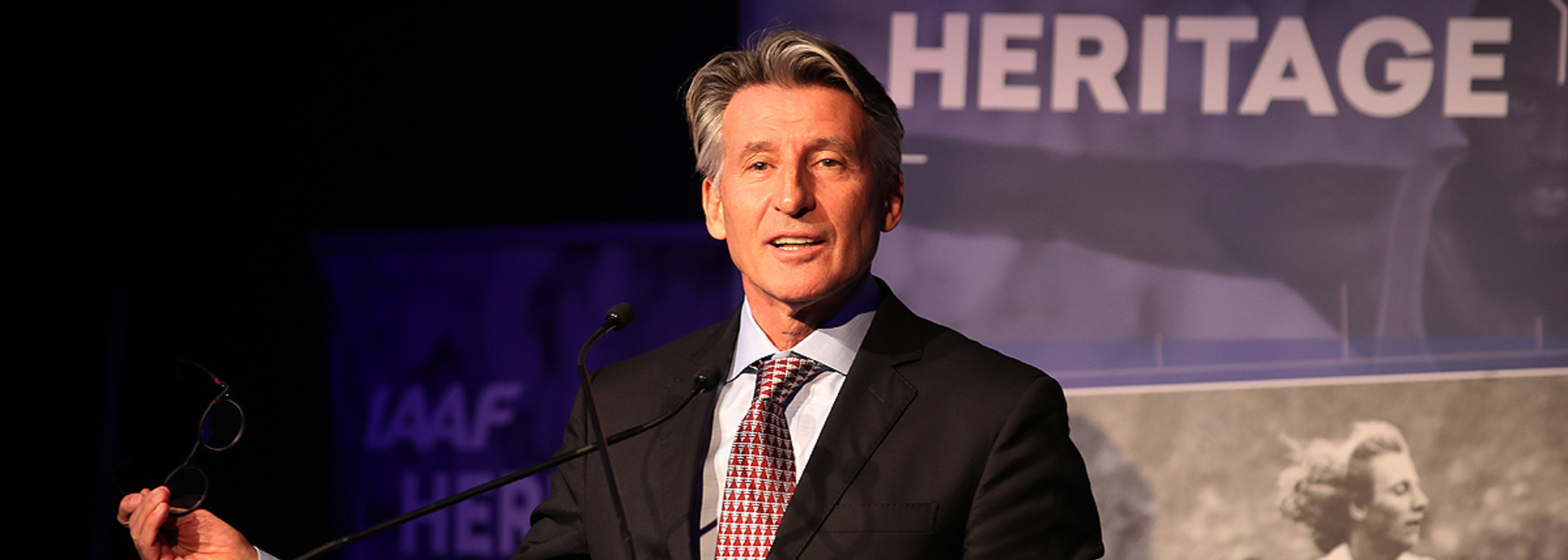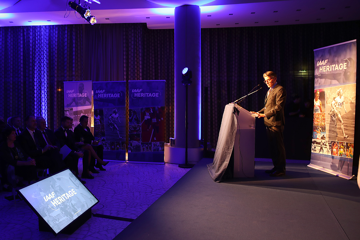IAAF President Sebastian Coe speaking at the IAAF Heritage Legends Reception (© Giancarlo Colombo)
IAAF President Sebastian Coe this evening announced the creation of the IAAF World Athletics Heritage Plaque.
Coe also opened a public competition to design the plaque and launched a dedicated plaque website section for the new award.
Coe made the announcements while hosting 150 guests at an IAAF Heritage Legends Reception in the Meridien Beach Plaza Hotel, Monaco.
The audience included representatives and family members of several deceased athletics legends including Paavo Nurmi, Jesse Owens, Fanny Blankers-Koen and Emil Zatopek. On stage each family presented Coe with historic artefacts from their relatives’ famous careers by donation to the IAAF Heritage Collection.
Coe commented: “The IAAF World Athletics Heritage Plaque is a location-based recognition which highlights, celebrates and links together iconic and historic athletics competitions, careers, performances, cities, venues, landmarks and culture around the world.”
A uniquely designed plaque will be permanently and publicly displayed at a location closely associated with each recipient.
Coe continued: “On the same principle that London’s world-famous blue plaque scheme celebrates notable people who have lived and worked in the British capital, the IAAF World Athletics Heritage Plaque sets out to recognise an outstanding contribution to the worldwide history and development of athletics.”
The plaque can be awarded in five different and broad categories (city; competition; legend; landmark; culture – full criteria here).
“This new award offers us the flexibility to honour locations across our multi-layered global sport,” said Coe.
A dozen locations covering all six IAAF continental areas, directly associated with a dozen legends were announced as the inaugural recipients of the IAAF World Athletics Heritage Plaque (in chronological order):
• Emil Voigt (GBR) - Manchester Harriers & Athletics Club, Manchester.
• Eric Lemming (SWE) / IAAF Foundation 1912 - Stockholm Olympic stadium, Stockholm.
• Paavo Nurmi (FIN) - Paavo Nurmi Games & Stadium, Turku.
• Mildred Didrikson (USA) - Babe Didrikson Zaharias Museum, Beaumont, Texas.
• Chuhei Nambu (JPN) - Meiji Jingu Gaien Nikoniko Park, Tokyo.
• Jesse Owens (USA) - Ferry Field, University of Michigan Wolverines, Ann Arbor, Michigan.
• Fanny Blankers-Koen (NED) - Fanny Blankers-Koen Games & Stadium, Hengelo.
• Emil Zatopek (CZE) - Golden Spike & Městský Stadion, Ostrava.
• Adhemar Da Silva (BRA) - Centro Esportivo e de Lazer Tietê, Sao Paulo.
• Betty Cuthbert (AUS) - Sydney Cricket & Sports Ground Trust, Sydney.
• Abebe Bikila (ETH) - Abebe Bikila Stadium, Addis Ababa.
• Irena Szewinska (POL) - Stadion Zawiszy Imienia, Bydgoszcz.
Coe, commenting about the first locations, said: “There would be no point in us placing plaques on the wall of every Olympic stadium as, while they have been the scene of countless epic competitions at the pinnacle of our sports history, these are already well-known landmarks. Instead we are looking to highlight lesser known locations associated with equally outstanding performances.”
“Many of the stadiums and tracks which we recognise today have already vanished and these plaques will be a permanent reminder of the incredible athletics deeds which took place at those locations.”
To illustrate, Japan’s Chuhei Nambu is the only man ever to have held the world record in both horizontal jumps. He set his long jump record in 1931 in the Meiji Jingu stadium which is now long since demolished. In fact, two stadiums have since been built on that spot. This is the site where the former National Stadium, which hosted the 1964 Olympic Games, stood. That is also now gone and the Tokyo 2020 Olympic stadium is now rising in its place.
Likewise Ferry Field, where Jesse Owens famously set four world records in 45 minutes on one afternoon in 1935, is also in transition mode. Modern athletics facilities have now been opened elsewhere in Ann Arbor as the new home of the University of Michigan Wolverines’ track and field team.
Coe concluded: “The launch of this award is an exciting day for our sport as we begin to link together the competitions, personalities and performances worldwide which have played an important role in athletics rich history. It is important for our sports future that we recognise that legacy.”
IAAF






